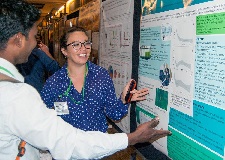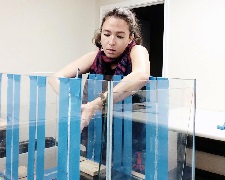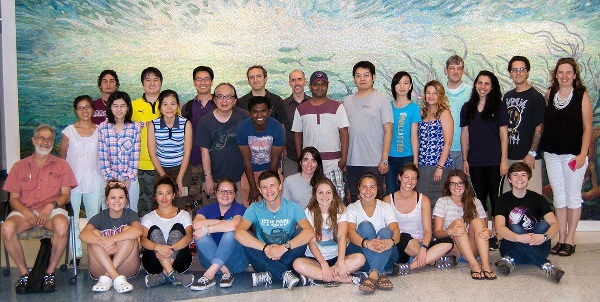
Maya presents her preliminary findings at the 2016 Gulf of Mexico Oil Spill and Ecosystem Science Conference. (Provided by Maya Morales-McDevitt)
Marine oil snow is the largest commuter of carbon to the seafloor and occurs when oil and marine particles aggregate and sink through the water column. Previous studies show that oil and dispersant significantly increased marine microorganisms’ production of exopolymeric substances (EPS), an extremely sticky goo that holds marine snow together. Maya Morales-McDevitt conducts mesocosm experiments investigating how certain naturally occurring nutrients influence EPS production and oil degradation.
Maya is a chemical oceanography student at Texas A&M University and a GoMRI Scholar with Aggregation and Degradation of Dispersants and Oil by Microbial Exopolymers (ADDOMEx).
Her Path
Maya discovered her love for the marine environment while attending a science-based high school in Mexico City, Mexico. Watching trash and oil pollutants negatively affect Mexico’s marine ecosystems broke her heart and inspired her to pursue research that demonstrates the importance of regulating oil pollution. “Oil pollution regulations aren’t very clear in Mexico,” she explained. “I wanted to contribute something that would keep the environment clean and reduce our footprint in the ocean.”
Maya’s undergraduate biology thesis at the Universidad Autónoma Metropolitana (UAM) México investigated how oil activity influences mussels. There were no active projects at the time, so she used the resources around her to conduct her own project. She asked her scuba instructor to take her on mussel-collecting excursions and washed dishes in various UAM and UNAM (Universidad Nacional Autónoma de México) laboratories in exchange for running analyses using their equipment. She presented her research at several international ecology conferences in Mexico. “When the person I was working with in Mexico put me in touch with Dr. Tony Knap, he told me to come [work in his lab], so I came,” she recalled. “Five or six months later, the ADDOMEx project started.”
Her Work

Maya builds a “baffled recirculation” tank to investigate accommodated oil fractions. (Provided by Maya Morales-McDevitt)
Maya used a 120 L tank to simulate the natural marine environment and created various mixtures of seawater, oil, dispersant. She examined each mixture once using the collected seawater’s indigenous nutrients (non-fertilized treatments) and again with added concentrations of nitrogen and phosphorus (fertilized treatments). She collected samples from each treatment and compared the differences in oil degradation, marine snow generation, and chlorophyll concentrations.
Maya observed that nitrogen and phosphorus were biodegraded at similar rates, indicating that both are important to oil degradation processes. While nutrient degradation was high across all treatments including controls, nutrient enhanced treatments exhibited greater oil biodegradation than non-fertilized treatments. She found the strongest evidence of biodegradation in the diluted and concentrated oil plus dispersant treatments from the coastal water experiments. Oil plus dispersant treatments also experienced sharp reductions in chlorophyll and exhibited the greatest amounts of marine snow.
Maya’s research suggests that adding nutrients could enhance oil’s natural removal from the water column alongside weathering processes such as marine snow sedimentation and biodegradation. Her work also supports the hypothesis that dispersant enhanced EPS production and, thus, increased marine snow. Her findings will help inform decision makers about ways to lessen oil spills’ environmental impacts. “The initial interest in marine snow and EPS was the possibility that they aided oil removal, but the new train of thought is that the excessive marine snow related to Deepwater Horizon caused more hostile effects than good ones,” she said. “In order to prevent [these hostile effects], we need to understand how it works.”
Her Learning

Maya filters 50 mL of each treatment for inorganic dissolved nutrient analyses. (Provided by Maya Morales-McDevitt)
Maya’s research showed her that scientists must consider the chemistry, physics, and biology of an ecosystem to understand it. Once their knowledge about these factors is improved, they are better equipped to find answers to their research questions. She remarked that one of the best ways to do this is to collaborate with other scientists. “We have physicists and chemists and biologists at our ADDOMEx All-Hands meetings who are all trying to solve problems. I think that has been one of my greatest experiences and the biggest lessons that I’ve learned in my master’s program,” she said.
Maya is particularly thankful for the support that she and other students received from the ADDOMEx team. She is most proud of how she and her team designed and built a baffled recirculation tank from scratch for their experiment. “It was very moving the way the PIs were always supporting us, pushing us to do more and do better and giving us all the advice that they could,” she said. One of her favorite memories is the struggle to fit fifteen researchers into the small, dark workspace surrounding the tanks. “I needed to be close to the tanks under very low light to take my samples. I ended up working in the men’s bathroom next to the dark room in order to take them! I will never forget my ‘laboratory’ in the men’s facilities,” she laughed.
Her Future
Shortly after graduating, Maya began a laboratory technician position with Texas A&M University’s Geochemical and Environmental Research Group (GERG) and hopes to begin a Ph.D. program in 2018. She says that persistence is the key to her success and advises students pursuing science to focus on their goals, even when the road is difficult. “You don’t need to be a genius or the most-outstanding student in your class, you just need to be determined,” she said. “If you fight enough, read enough, and do enough research and lab work, you will get wherever it is you want to go.”

Maya and fellow ADDOMEx members on the last day of the mesocosm experiments held at Texas A&M University – Galveston in July 2016. (Provided by Maya Morales-McDevitt)
Praise for Maya
Dr. Knap reflected that Maya’s work building mesocosms and running experiments often involved late nights and long days. While working in his lab, Maya learned to operate various instruments including fluorometers, gas chromatographs, and auto-analyzers, which he said could often be a highly involved process. “Maya is a hard-worker and very cheerful individual,” he said. “She is a great team player, and it was a pleasure to have her involved with our programs at GERG.”
The GoMRI community embraces bright and dedicated students like Maya Morales-McDevitt and their important contributions. The GoMRI Scholars Program recognizes graduate students whose work focuses on GoMRI-funded projects and builds community for the next generation of ocean science professionals. Visit the ADDOMEx website to learn more about their work.
************
The Gulf of Mexico Research Initiative (GoMRI) is a 10-year independent research program established to study the effect, and the potential associated impact, of hydrocarbon releases on the environment and public health, as well as to develop improved spill mitigation, oil detection, characterization and remediation technologies. An independent and academic 20-member Research Board makes the funding and research direction decisions to ensure the intellectual quality, effectiveness and academic independence of the GoMRI research. All research data, findings and publications will be made publicly available. The program was established through a $500 million financial commitment from BP. For more information, visit http://gulfresearchinitiative.org/.
© Copyright 2010- 2017 Gulf of Mexico Research Initiative (GoMRI) – All Rights Reserved. Redistribution is encouraged with acknowledgement to the Gulf of Mexico Research Initiative (GoMRI). Please credit images and/or videos as done in each article. Questions? Contact web-content editor Nilde “Maggie” Dannreuther, Northern Gulf Institute, Mississippi State University (maggied@ngi.msstate.edu).
